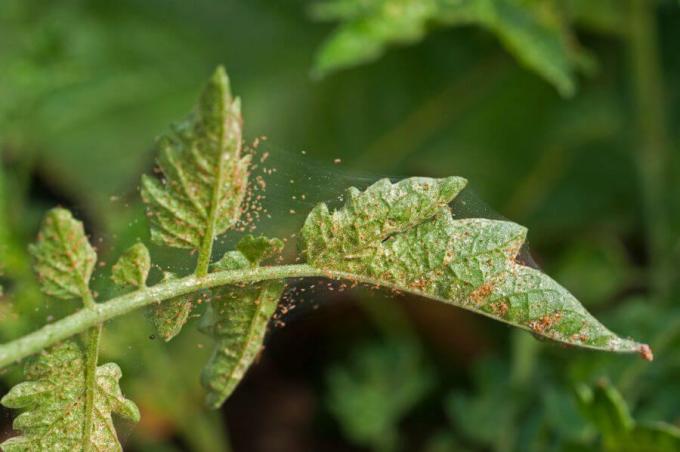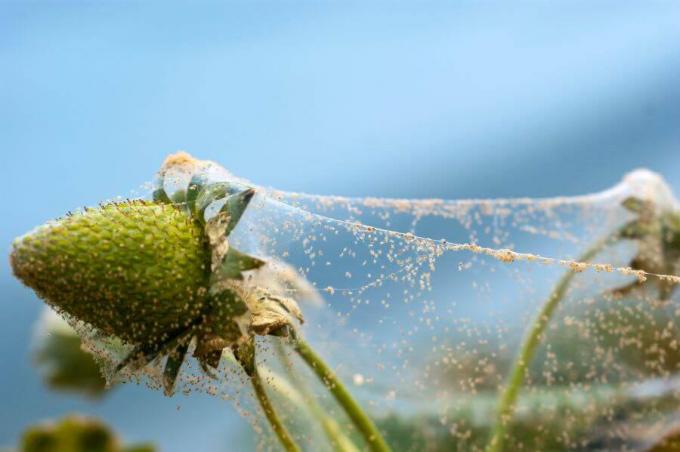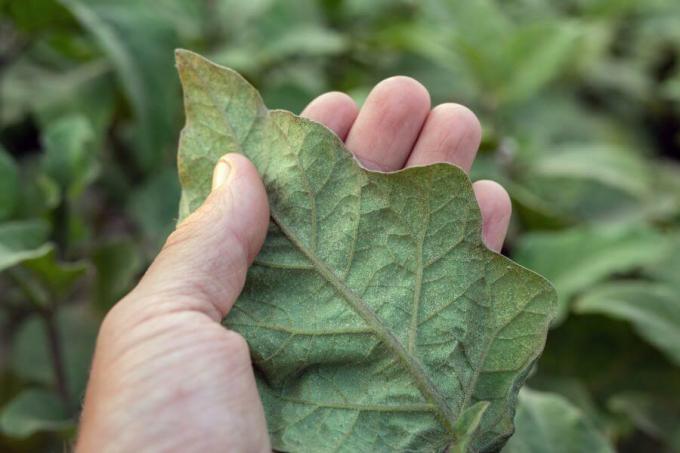A spider mite infestation is a nightmare for many gardeners. We show how to recognize the damage and how to fight the annoying spider mites naturally and with home remedies.
Every hobby gardener who has had an unwelcome visit from spider mites knows how stubborn the little arachnids can be. Whether roses (pink), fruit trees, the oleander (Nerium oleander) in the garden or orchids (Orchidaceae), Ficus (Ficus benjamina) or the citrus tree (citrus) on the windowsill - Spider mites can affect a variety of plants. straight tomatoes (Solanum lycopersicum), cucumbers (Cucumis sativus) and other vegetables cultivated in the greenhouse are a popular target for the small mites. If the spider mites only appear in small numbers, they usually go unnoticed. In dry and warm or hot weather, however, the number of spider mites increases rapidly and the animals quickly become a real problem.
contents
- Identify spider mites
- Spider mite damage
-
Fight spider mites
- Fight spider mites naturally
- Fight spider mites with home remedies
- Combat spider mites with beneficial insects
- Prevent spider mites
Identify spider mites
Spider mites (Tetranychidae) are arachnids and accordingly have eight legs. The rear two pairs of legs are rather inconspicuous, whereas the front ones are used more and are clearly visible. Externally, the mites can differ greatly. The color spectrum of the adult animals ranges from yellow to green to red, which is where the common name "red spider" comes from. In Germany, the common spider mite (Tetrnychus urticae) and the fruit tree spider mite (Panonychus ulmi) known as the most common plant-damaging spider mite. At well under a millimeter, the tiny animals are so small that they are difficult to see with the naked eye. Only when the infestation is advanced can small webs of mites be seen on leaf stalks or branches. With the help of a magnifying glass, the small spider mites can be seen on these webs. An infestation by spider mites can be noticed above all on the webs and the damage caused by the spider mites.
Tip: By spraying the plant with water using an atomizer, the webs become more visible as small droplets stick to them.
Spider mite damage
Unlike aphids, which pierce the ducts, the spider mites only suck out individual leaf cells, resulting in characteristic punctiform brightening. The brightening on leaves or flowers spreads with ongoing infestation. This can result in deformed shoot tips or infested parts of the plant drying out. In addition, webs with a large number of small spider mites can be seen.

Fight spider mites
Even if spider mites are very small and don't actually look particularly resilient: These animals are very stubborn! The spider mites not only weaken the plant and make it look extremely unsightly, but can also transmit plant viruses. In addition, it is possible for them to affect a large number of different plants, which allows for rapid spread. It is therefore particularly important for this pest to detect an infestation at an early stage and to take immediate control measures to prevent it from spreading.
The first step in identifying an infestation should be to isolate the plant, if possible. In this way you can avoid attacking neighboring plants.
Fight spider mites naturally
We advise against the use of synthetic pesticides, especially in the house garden or in living rooms, as these usually have a high potential for damage to beneficial insects in the garden. In addition, spider mites are resistant to some synthetic active ingredients or the use of the agents is not recommended so as not to promote resistance. Biological preparations are commercially available, many of which, however, do not have a systemic effect. Multiple applications are therefore required, which can be bad for both the environment and the plant. Some pesticides contain active ingredients from the pyrethrin group, which are of plant origin but can harm beneficial insects in your garden. We therefore recommend that you avoid using these products as well. Biological agents based on pure rapeseed oil are environmentally friendly, but require thorough and repeated treatment. Preparations based on potash soap are also environmentally friendly, but repeated treatment is also necessary here.

Summary: How to get rid of spider mites naturally
- If possible, isolate the affected plant to prevent spread.
- Synthetic agents only have a limited effect due to resistance and are harmful to the environment.
- Biological preparations based on rapeseed oil or potash soap are effective, but require repeated use.
Fight spider mites with home remedies
Home remedies against spider mites can only be used to a very limited extent. If it is an outdoor plant, you should remove particularly badly infested shoot tips or plant parts from plants that tolerate pruning. Since spider mites do not like moisture, a slight infestation can be achieved by rinsing the entire plant with a garden hose or in the shower every day.
Another home remedy for spider mites is to put a plastic bag over affected houseplants to increase humidity. However, the air underneath can heat up so much that the affected plant can also be seriously damaged. We therefore advise you to only leave the plastic bag over the plant for four days and, after a two-day break, put the bag over the plant again for four days. You can also put an infested houseplant outside in summer when it rains.

Last but not least, the application of a water-oil emulsion with rapeseed oil promises to fight the spider mites. For this purpose, 70 milliliters of water are mixed with 30 milliliters of oil and whipped vigorously so that a white emulsion is formed. This is then applied to the whole plant, including the underside of the leaves. But beware: During the process, shake the squeeze bottle again and again so that the components do not separate. Unfortunately, many plants do not tolerate treatment with rapeseed oil very well, as it loosens the protective cuticle of the leaves. It is therefore better to only use rapeseed oil as a remedy against spider mites in the evening when the sun is not shining so strongly. Repeat the application a maximum of three times so as not to weaken the plant too much.
If this measure does not have an effect within a week, you should use a biological pesticide.
Summary: Home remedies for spider mites
- Isolate affected plants if possible
- Remove affected parts of the plant as much as possible
- Rinse affected plants with water daily
- Put a plastic bag over the infested plant to increase the humidity underneath
- Put indoor plants in the rain in summer
- Prepare spray mixture from 70% water and 30% rapeseed oil; so treat plants a maximum of three times
Combat spider mites with beneficial insects
Beneficial insects can also be used in the event of an infestation by spider mites. predatory mites like Phytoseiulus persimilis or gall midges like Feltiella acarisuga can help you keep the pests under control. The use of predatory mites makes sense above all in the greenhouse and in the house, where spider mites ultimately cause the greatest damage. There the beneficial insect cannot migrate so quickly and even if the name "predatory mite" seems dangerous, the animals are not dangerous for humans. Outdoors, it makes more sense to encourage naturally occurring predatory mites through a natural garden design. While you specifically use beneficial insects against spider mites, you should not use any pesticides, as these could harm the beneficial insects.

Prevent spider mites
Spider mites can be resistant to some crop protection products, which makes preventive measures particularly interesting. In the garden, the risk of spider mite infestation is particularly high in dry weather and hot temperatures, because the little animals prefer this weather. You can prevent spider mites as follows:
- beneficials like gall midges can now help you keep the pests in check. Through natural flower beds with flowering herbs such as chamomile (Matricaria chamomilla), attract gall midges and other beneficial insects. A blooming meadow or tub with beneficial flowering plants can be easily treated with special mixtures such as ours Plantura beneficial insect magnet invest. We also recommend that you take plant protection measures that are gentle on beneficial insects in the event of a pest infestation, so as not to harm your little helpers.
- If it is too high nitrogen fertilization your plants are particularly susceptible to spider mites. We therefore recommend restrained nitrogen doses and organic fertilizers. With our Plantura organic fertilizers you can supply your plants with the nutrients they need without making them susceptible to pests.
- In greenhouses you can use the Influencing temperature and humidity avoid a heavy infestation. You should make sure that the humidity does not drop too much and the temperature must not rise too high. Spider mites develop extremely quickly at around 30 °C and air that is as dry as possible.
- In the house and straight to winter season the spider mite also becomes a problem: You should be particularly careful when you bring potted plants indoors for the winter. Examine the plants to be overwintered meticulously for spider mites. Spider mites can multiply optimally in the winter when there is dry, warm heating air in the apartment.
How you targeted predatory mites can be used against spider mites or against thrips, you can find out in our special article.
